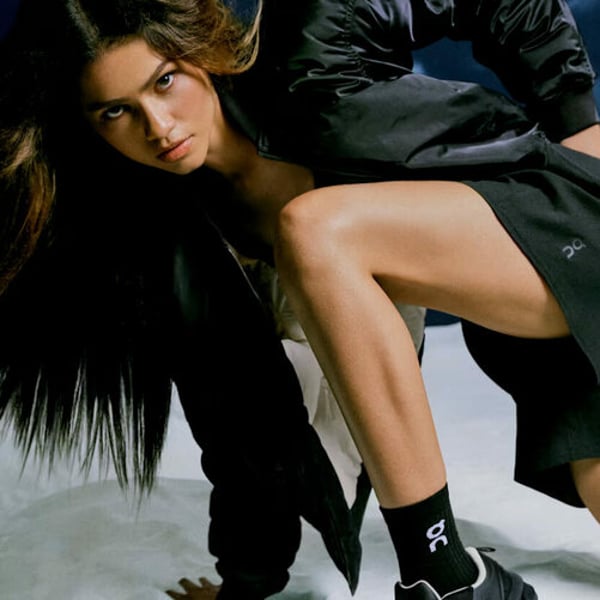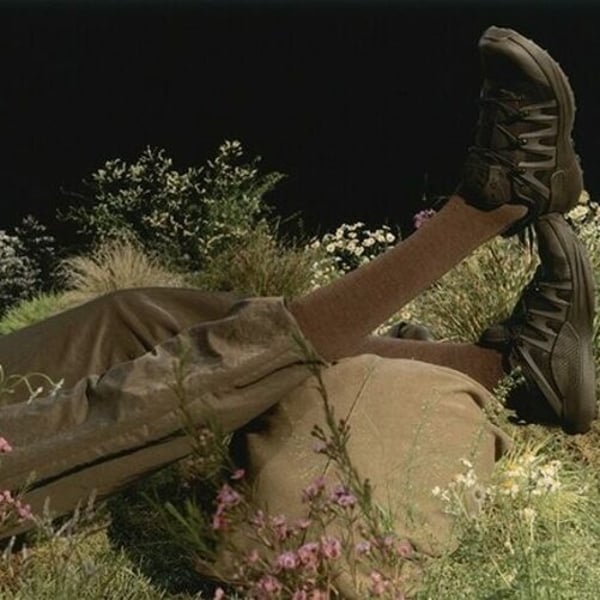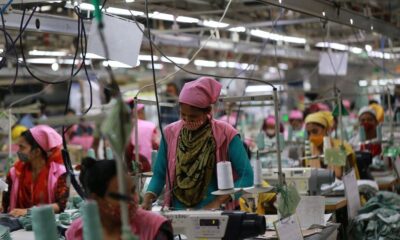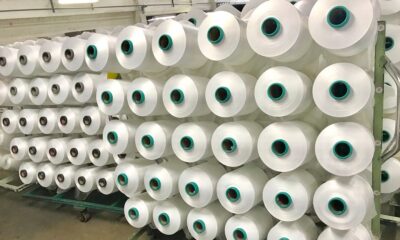Fashion
The House of Dior Beverly Hills opens on Rodeo Drive

Published
October 1, 2025
In 1990, Dior opened its first store on Rodeo Drive, the first Dior location in North America. Thirty-five years later, the luxury brand owned by the LVMH group has just opened a 60-foot-tall building.
Open to the public since Saturday, the store located at 323 North Rodeo Drive called upon its star architect, Peter Marino, chief designer of Dior boutiques, including most recently, 30 Avenue Montaigne in Paris and the new flagship store House of Dior New York, which opened in August.
The magnificent, undulating stucco façade now revealed its window displays featuring miniature scenes of Paris, including an ultra-detailed model of La Galerie Dior at 30 Avenue Montaigne, complete with characters, realistic settings, and nods to Los Angeles with the “HollywoodDior” sign and the Bel-Air hotel.
“A cinematic journey, a luminous dialogue between Paris and Los Angeles that pays tribute to the house’s timeless couture heritage,” explains Dior’s team, “each offering a living tableau of small scenes from Dior’s odyssey in the United States.”

These animations can also be found on the second floor of the store, in the jewelry section, where a window display pays tribute to designer Christian Dior, accompanied by his faithful dog Bobby.
Surrounded by a garden featuring a dancing sculpture by artist Niki de Saint-Phalle, the boutique reveals an interior with light-colored parquet flooring strewn with antique rugs and a palette of natural, earthy colors. In the center stands the sculptural “Ginkgo” bench designed by sculptor and artist Claude Lalanne in the late 1990s, from which several bouquets of flowers spring forth.
On the ground floor, visitors first discover the space reserved for leather goods and handbags, furnished with seating areas and counters. This is followed by an area dedicated to women’s shoes, decorated with sculptural tables and large speckled benches, and another dedicated to perfumes. A corner showcases the house’s scarves, presented on wall displays and in a large trunk. In each space, Dior silhouettes blend into the decor.

In contrast, the men’s section plays on other motifs and a color palette combining brown, camel, and gray tones. The sunglasses collections, all the leather goods for men, and ready-to-wear are presented here.
The store’s centerpiece, the majestic staircase, a nod to the Barneys New York store in Los Angeles designed by Peter Marino 38 years ago, surrounds a small garden designed by Marino in collaboration with landscape architect Peter Wirtz, offering a panoramic view of the spaces.
There are a number of small lounges dedicated to women’s ready-to-wear in a Parisian apartment-style setting with Dior gray walls, large mirrors, and angel tapestries. Divided by large gold and silver stone walls, the jewelry and fine jewelry area showcases the house’s latest collections in circular metal display cases. There is also an area dedicated to men, with large fitting rooms and two VIP rooms.

Dotted with numerous art pieces by Frederic Heurlier-Cimolai, Adam Fuss, and Horst P. Horst, the boutique also unveils many pieces of furniture in bronze, brass, metal, and aluminum by the Voukenas Petrides studio, artist Audiane Delos, and Maison Leleu.
One floor up, the house opens its VIP area around a huge terrace overlooking the Hollywood sign and its restaurant, Monsieur Dior. The space, whose menu has been designed by San Francisco’s three-star chef Dominique Crenn, is set to open to the public in the last week of October. It features a lounge with a bar and an indoor-outdoor dining room that can accommodate up to 105 guests. The menu is inspired by the golden age of Hollywood and, of course, glamorous fashion.
Copyright © 2025 FashionNetwork.com All rights reserved.
Fashion
On runs in Europe, sprints in Asia

Published
November 19, 2025
On has found a new playing field in Asia. In the third quarter of 2025, when its sales rose by nearly 25% year on year (35% at constant exchange rates) to net revenue of 794 million Swiss francs (860 million euros), sales in the Asia-Pacific region surged. They reached 145 million Swiss francs for the quarter, an increase of 109% at constant exchange rates, more than doubling to account for almost 20% of the Swiss sports brand’s total revenue.
In a conversation with financial analysts, the company noted that the opening of the Ginza flagship in Tokyo showcased the strength of this strategy, generating the highest monthly sales in the brand’s global network. For the group, scaling up in the region is strategic.
“Japan set the tone, but the Asia-Pacific region has shown the scale of what’s possible,” explained Martin Hoffmann, the company’s chief executive and chief financial officer.
“We’re connecting with a new generation of younger, deeply design-conscious customers, proving the worldwide appetite for On’s premium, performance-led approach. What was once a new frontier has become a major engine for the brand.”
The brand is expanding into new markets and recently opened its first two stores in South Korea, in Seoul at The Hyundai Seoul department store and at Lotte World Mall Jamsil. It also intends to build momentum in Greater China.
This points to a rapid rebalancing between the company’s regions worldwide. In the quarter, the Americas remained the brand’s largest market, with 436 million Swiss francs, up 10.3% (21% at constant exchange rates). The Europe-Middle East-Africa (EMEA) region generated 213 million Swiss francs, an increase of 29% (+33.0% at constant exchange rates).
“Europe, the Middle East and Africa delivered an exceptional quarter… We are seeing incredible demand in the UK, which has firmly established itself as one of our largest global markets, tremendous momentum in newer markets such as France and Italy, and a sustained re-acceleration of growth in the German-speaking region,” the chief executive told analysts.
He also highlighted the significant contribution of the Champs-Élysées store in Paris to the brand’s appeal. The brand will apply the same strategy in Spain, with the opening this weekend of a flagship store in Madrid, on Calle Serrano.
Direct sales rose sharply to 315 million Swiss francs, up 28% on the same period a year earlier. The wholesale channel posted sales of 480 million Swiss francs, up 23%. Above all, On’s management emphasises its strategy of positioning On in the premium segment of the sports-lifestyle market. Despite an inflationary environment, price increases in the key U.S. market have not dented demand. According to management, this validates the brand’s pricing power. Meanwhile, the company posted a record gross margin of 65.7% for the quarter, up 510 basis points year on year.

Another important takeaway for the Swiss brand is that it no longer relies solely on its footwear range, which is regularly refreshed with new models. By product category, third-quarter footwear sales totalled 731 million Swiss francs, up 21.1% (+30.4% at constant exchange rates). Apparel generated 50 million Swiss francs, up 87% (+100.2% at constant exchange rates), and accessories 13.0 million Swiss francs, up 145% (+160.8%).
Granted, apparel still represents a small share of On’s performance. But the outlook is encouraging for its chief executive: “We are not building apparel as a complement to our footwear business, but as a business within the business, serving the same communities, but with a unique product offering and customer experience. The result is that apparel generates high-value incremental growth across all our channels.” It remains to be seen whether collaborations with Zendaya or Burna Boy will boost its lifestyle sales.
Net income came to 119 million Swiss francs, up 290% year on year, for a net margin of 15% versus 4.8%. For the first nine months of the year, sales reached 2.270 billion Swiss francs, compared with 1.712 billion a year earlier, an increase of 33% (+37% at constant exchange rates). Net income declined to 135 million Swiss francs (compared with 153 million in 2024), while adjusted EBITDA reached 436 million Swiss francs (+51%) for a margin of 19% (compared with 17%).
On has raised its forecasts for 2025: constant-currency sales growth is now expected to increase by 34%, corresponding to revenue of around 2.98 billion Swiss francs. Gross margin is now targeted at “around 62.5%” and adjusted EBITDA margin above 18%.
It should be noted that the decline in net income over nine months is a reminder that growth is also accompanied by challenges related to currency effects, logistics costs and strategic investments.
This article is an automatic translation.
Click here to read the original article.
Copyright © 2025 FashionNetwork.com All rights reserved.
Fashion
Kering must downsize, reduce Gucci exposure and chase synergies, CEO de Meo says in memo

By
Reuters
Published
November 18, 2025
Kering‘s return to growth will require reducing its reliance on struggling flagship Gucci, further scaling back its store network and chasing more synergies, Chief Executive Luca de Meo said in a memo seen by Reuters.
The document, a summary of a more detailed memo dubbed “ReconKering” recently sent to senior staff, offers the first detailed overview of de Meo’s strategic vision for the group.
Emerging less than a month after the group struck a deal to offload its beauty divisionin a $4.7 billion euro deal with l”Oreal to raise much-needed cash and focus on its core luxury fashion business, the note is marked by a candid, yet modest tone.
“We remain humble,” de Meo wrote in the note, saying that his ambition was to “become the undisputed challenger in luxury” in five to ten years.
Long seen as a threat to its larger French rival LVMH, Kering has been grappling with a double-digit sales decline at its flagship label Gucci while piling up debt through acquisitions.
De Meo in the memo sets a 18-month timeline to get all brands back on the growth track, while saying that restoring a “top financial performance” will take three years.
Kering said in a statement de Meo outlined “the foundations of Kering’s future strategic plan” when taking over the helm in September, which have since been “broadly communicated with employees.”
The official strategy plan will be presented to investors next spring, it added.
In the note, de Meo said the company, which has closed 55 stores in the past year, further needs to downsize its retail network and rethink its price positioning and assortment after years of price hikes.
It also needs to cut back what de Meo called an “overdependency” on Gucci by developing its Saint Laurent, Bottega Veneta and Balenciaga brands.
The group’s jewellery division, which has struggled to scale up and compete with the brands of larger rivals LVMH and Richemont, needs to chase synergies, de Meo said.
Among the brands to develop, de Meo also cited suit maker Brioni, which has been rumoured as a likely divestment candidate along with loss-making fashion label Alexander McQueen.
Kering shares, which had lost over half of their value in two years, have risen by 75% since de Meo was hired to succeed controlling shareholder Francois-Henri Pinault as chief executive.
© Thomson Reuters 2025 All rights reserved.
Fashion
Amer Sports logs double-digit sales growth on Salomon, Arc’teryx

Published
November 18, 2025
Amer Sports announced on Tuesday sales increased 30% to $1.76 billion for the third quarter, on the back of double-digit growth across all segments led by the Salomon and Arc’teryx brands.
By segment, technical apparel sales, including Arc’teryx, rose 31% to $683 million, while outdoor performance sales, including footwear brand Salomon, surged 36% to $724 million for the three months ending September 30.
Meanwhile, ball and racquet sports sales, including the Wilson brand, increased 16% to $350 million for the quarter.
By region, Asia-Pacific sales surged 54% to log the biggest growth, followed by Greater China sales, up 47%, EMEA, up 23%, and the Americas, up 18% during the quarter.
As a result of the strong quarter, net income surged 156% to $143 million, or $0.25 diluted earnings per share at Helsinki-headquartered company.
“Amer Sports’ strong momentum continued in the third quarter, as our unique portfolio of premium technical brands continues to create white space and take share in sports and outdoor markets around the world,” said Amer Sports CEO, James Zheng.
“All three segments performed extremely well led by exceptional Salomon footwear growth, an Arc’teryx omni-comp re-acceleration, and solid growth from Wilson Tennis 360 and our Winter Sports Equipment franchises.
“We believe our specialized, highly technical brands are well positioned within the premium sports and outdoor market, which continues to be one of the healthiest segments across the global consumer landscape.”
Looking ahead, the company expects sales growth to be between 23% and 24% for the full-year.
Copyright © 2025 FashionNetwork.com All rights reserved.
-

 Tech1 week ago
Tech1 week agoFrom waste to asset: Turning ethanol production CO₂ into jet fuel
-

 Tech3 days ago
Tech3 days agoNew carbon capture method uses water and pressure to remove CO₂ from emissions at half current costs
-

 Politics5 days ago
Politics5 days agoBritish-Pakistani honoured for transforming UK halal meat industry
-

 Sports3 days ago
Sports3 days agoTexas A&M officer scolds South Carolina wide receiver after touchdown; department speaks out
-

 Business4 days ago
Business4 days agoThese 9 Common Money Mistakes Are Eating Your Income
-

 Tech1 week ago
Tech1 week agoSecurity flaws in portable genetic sequencers risk leaking private DNA data
-

 Business4 days ago
Business4 days agoWhat’s behind Rachel Reeves’s hokey cokey on income tax rises?
-

 Fashion1 week ago
Fashion1 week agoBangladesh garment makers eye $5 bn more in exports post policy tweak


















